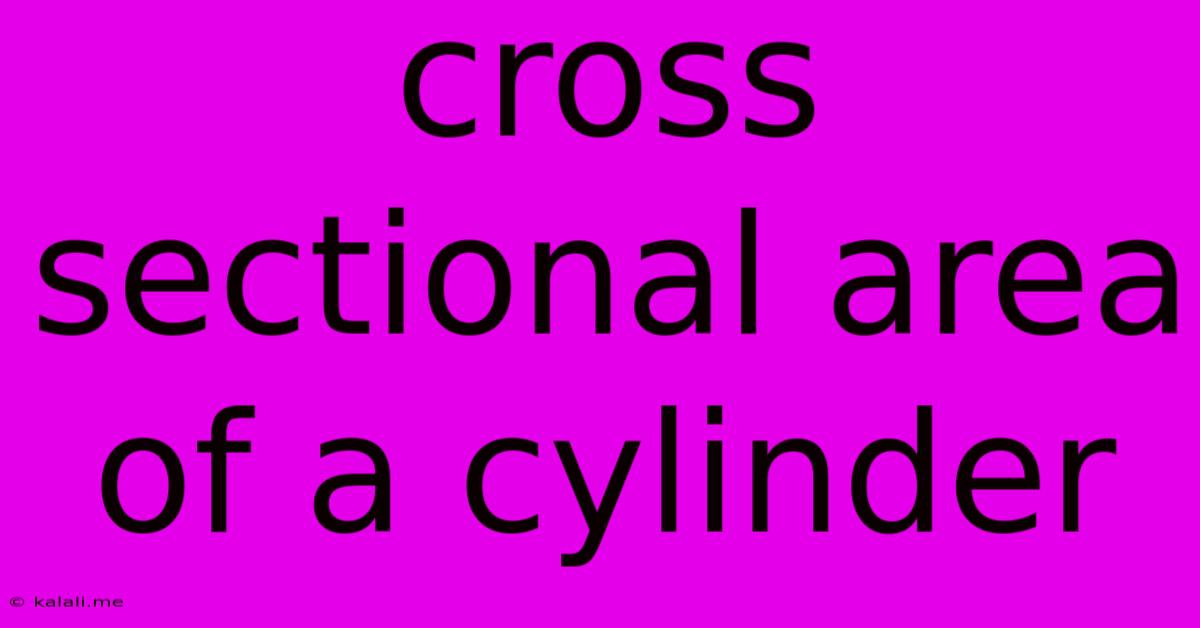Cross Sectional Area Of A Cylinder
Kalali
May 29, 2025 · 3 min read

Table of Contents
Understanding the Cross-Sectional Area of a Cylinder: A Comprehensive Guide
Calculating the cross-sectional area of a cylinder is a fundamental concept in various fields, from engineering and physics to architecture and manufacturing. This article provides a clear and comprehensive guide to understanding this calculation, including different scenarios and practical applications. Whether you're a student tackling geometry problems or a professional needing to solve real-world engineering challenges, this guide will equip you with the knowledge you need.
What is Cross-Sectional Area?
The cross-sectional area refers to the area of a two-dimensional shape that is obtained when a three-dimensional object is sliced perpendicularly to its longitudinal axis. In the case of a cylinder, this means the area of the circle formed when cutting through the cylinder parallel to its base. Understanding this area is crucial for various calculations, including volume, stress analysis, and fluid flow.
Calculating the Cross-Sectional Area of a Cylinder
The formula for calculating the cross-sectional area of a cylinder is straightforward:
Area = πr²
Where:
- π (pi) is a mathematical constant, approximately equal to 3.14159.
- r is the radius of the cylinder's circular base (half of the diameter).
Step-by-Step Calculation:
- Identify the radius: Measure the diameter of the cylinder's circular base. The radius (r) is half of the diameter.
- Square the radius: Multiply the radius by itself (r * r = r²).
- Multiply by π: Multiply the squared radius by π (approximately 3.14159).
- Units: Remember to include the appropriate units (e.g., square centimeters, square inches, square meters) in your answer.
Example:
Let's say we have a cylinder with a diameter of 10 cm.
- Radius: The radius is half the diameter, so r = 10 cm / 2 = 5 cm.
- Square the radius: r² = 5 cm * 5 cm = 25 cm².
- Multiply by π: Area = π * 25 cm² ≈ 78.54 cm².
Therefore, the cross-sectional area of this cylinder is approximately 78.54 square centimeters.
Different Perspectives and Scenarios:
While the standard cross-section is a circle, it's important to note that the cross-sectional area can vary depending on the plane of the cut. A cut at an angle to the longitudinal axis will result in an ellipse with a different area calculation. However, the most commonly used and relevant cross-sectional area is the circular one, as described above.
Applications of Cross-Sectional Area Calculation:
The cross-sectional area of a cylinder finds applications in numerous fields:
- Fluid Dynamics: Calculating fluid flow through pipes and tubes.
- Structural Engineering: Determining stress and strain on cylindrical components.
- Material Science: Analyzing the properties of cylindrical materials.
- Electrical Engineering: Calculating the resistance of cylindrical wires.
- Volume Calculation: Combined with the cylinder's height, the cross-sectional area is used to determine its volume (Volume = Area * Height).
Conclusion:
Calculating the cross-sectional area of a cylinder is a crucial skill with a wide range of practical applications. By understanding the simple formula and following the steps outlined above, you can easily determine this important geometric property. Remember to always double-check your units and consider the context of your problem to ensure accurate results. This knowledge is valuable in various scientific and engineering disciplines.
Latest Posts
Latest Posts
-
How To Get Stone Bricks In Minecraft
May 30, 2025
-
Wire Size For 125 Amp Breaker
May 30, 2025
-
Getting Warm In A Sunny Window
May 30, 2025
-
My Min Plant Wont Stand Upright
May 30, 2025
-
How Do You Say Welcome Back In Spanish
May 30, 2025
Related Post
Thank you for visiting our website which covers about Cross Sectional Area Of A Cylinder . We hope the information provided has been useful to you. Feel free to contact us if you have any questions or need further assistance. See you next time and don't miss to bookmark.